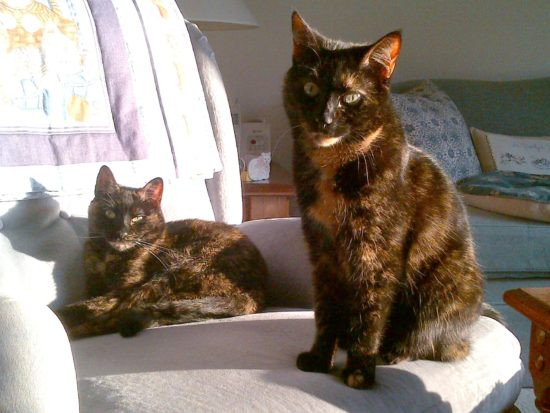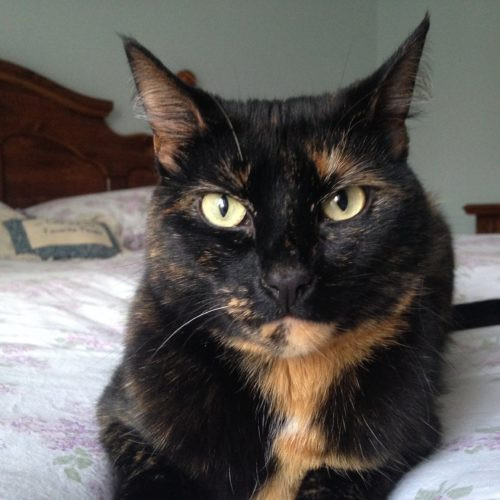Tortoiseshell cats, with their striking mosaic coats of black, orange, and red, are often associated with a unique and spirited temperament. The term “tortitude” has even been coined to describe this distinctive personality. But is there any truth behind the stereotype, or is it simply folklore? Let’s delve into the captivating world of the Tortoiseshell Cat Personality, exploring the science, the stories, and the expert opinions that paint a vivid picture of these feline enigmas.
 A beautiful tortoiseshell cat with striking colors
A beautiful tortoiseshell cat with striking colors
What Exactly is a Tortoiseshell Cat?
Firstly, it’s crucial to understand that “tortoiseshell” refers to a coat color pattern, not a specific breed. These captivating colors – a blend of black, brown, amber, red, cinnamon, and chocolate – appear in various breeds, from domestic shorthairs to Persians. The patches can range dramatically, creating anything from subtle speckling to bold, distinct markings.
Often confused with calico cats, tortoiseshells primarily lack significant white patches. Calicos, in contrast, are also tri-colored but feature large areas of white fur alongside black and orange. Variations within the tortoiseshell pattern also exist. Dilute torties showcase softer, muted shades like grey and cream, while “chocolate torties” are characterized by a darker base with rich black tones. Furthermore, the tortoiseshell pattern can sometimes overlay a tabby pattern, resulting in “torbies,” cats with striped tortoiseshell markings.
The Genetics Behind the Tortoiseshell Coat and Temperament
The intriguing link between the tortoiseshell coat and personality might be rooted in genetics. The vibrant tortoiseshell pattern arises from the complex interplay of genes, particularly the sex-linked genes on the X chromosome. The primary coat color in cats is determined by one gene, while the tortoiseshell pattern itself is produced by two co-dominant genes. These genes express themselves simultaneously, creating the characteristic mottled or brindled effect. In dilute torties, a recessive gene modifies these colors, leading to softer hues.
Interestingly, the vast majority of tortoiseshell cats are female. This is because the genetic coding for both black and orange colors resides on the X chromosome. Females, with their XX chromosome pairing, can naturally inherit and express both color genes. Males, possessing XY chromosomes, typically cannot. Male tortoiseshells are rare genetic anomalies, usually resulting from an XXY chromosome configuration. Studies, like one from the College of Veterinary Medicine at the University of Missouri, estimate that only about 1 in 3,000 tortoiseshell cats are male.
This strong female predisposition in tortoiseshells raises a question: could the perceived “tortitude” be linked to hormonal or genetic factors associated with sex, or is it purely coincidental? While direct genetic links between coat color genes and personality are not definitively proven in cats, the unique genetic makeup of tortoiseshells makes the question worth considering.
Tortoiseshell Cat Folklore: Myths and Legends
Beyond genetics, tortoiseshell cats are steeped in folklore across various cultures, often associated with good fortune and even mystical qualities. Historically, the rare male tortoiseshell held particular significance. Celtic tradition considered a male tortie staying in the home a harbinger of good luck. English folklore suggested that warts could be cured by rubbing them with a male tortoiseshell’s tail in May. Japanese fishermen believed male torties protected their vessels from storms and malevolent spirits. A Khmer legend from Southeast Asia poetically describes the first tortoiseshell cat arising from the menstrual blood of a goddess born from a lotus flower.
 A tortoiseshell cat in a relaxed pose, embodying the "tortitude" concept
A tortoiseshell cat in a relaxed pose, embodying the "tortitude" concept
In many cultures, torties are viewed as lucky charms, sometimes even dubbed “money cats.” They were also once believed to possess psychic abilities and the power to foresee the future. Dreaming of a tortoiseshell cat was considered a sign of good luck in love. While these are charming myths, they contribute to the enduring mystique surrounding the tortoiseshell cat personality.
“Tortitude” Examined: Real Trait or Just a Stereotype?
The concept of “tortitude” suggests that tortoiseshell cats are inherently more strong-willed, independent, and even a bit feisty compared to cats of other colors. Anecdotal evidence from tortie owners often supports this idea, describing their cats as vocal, demanding, and full of character. However, is “tortitude” a scientifically recognized personality trait, or just a fun generalization?
Personal experiences vary widely. Some owners report their tortoiseshells perfectly embodying the “tortitude” stereotype – exhibiting spirited, sometimes temperamental behavior. Others find their torties to be gentle, affectionate, and even shy, challenging the notion of a universal tortie personality. Just like humans, individual cats, even those with the same coat color, possess diverse personalities shaped by genetics, environment, and life experiences.
Experts in feline behavior offer interesting perspectives. Dr. Fern Slack, a feline veterinarian, playfully compares torties to “redheads of the cat world,” suggesting a reputation for being beautiful but potentially short-tempered. She notes approaching torties with “a tad more circumspection,” while also acknowledging their capacity for immense love. This highlights the nuanced view – “tortitude” might represent a tendency towards strong personalities, but not a guarantee of specific behaviors in every tortie.
Dr. Elizabeth Colleran, a former president of the American Association of Feline Practitioners, emphasizes that there’s no definitive scientific evidence linking coat color genes directly to personality. She points out that the perception of “tortitude” might be influenced by the fact that most torties are female, and female cats are sometimes stereotyped as more independent. She stresses that personality is a complex mix of genetics and environmental factors.
Cat behaviorist Jackson Galaxy acknowledges “tortitude” as a “very real thing” in his experience. He suggests that torties and calicos might be more “energetically sensitive,” contributing to their seemingly more pronounced personalities. He views cats as “energetic sponges,” and believes torties may absorb and express more energy, leading to their distinctive behaviors.
Embracing the Unique Tortoiseshell
Ultimately, while “tortitude” might be a fun and often accurate descriptor, it’s crucial to remember that every cat is an individual. Not all tortoiseshell cats will exhibit the stereotypical traits, and attributing specific personality characteristics solely based on coat color is an oversimplification. However, the enduring popularity of the “tortitude” concept and the shared experiences of many tortie owners suggest there might be something special about these cats.
Whether it’s genetics, folklore, or simply a shared set of personality traits within the predominantly female tortoiseshell population, these cats captivate with their beauty and spirit. Those who love torties appreciate their unique personalities, embracing both the cuddly moments and the occasional bursts of “tortitude.” For many tortie owners, the spirited, sometimes unpredictable nature of their tortoiseshell companions is precisely what makes them so endearing. The “tortitude,” real or perceived, is simply part of the charm of living with these magnificent, multi-colored felines.

